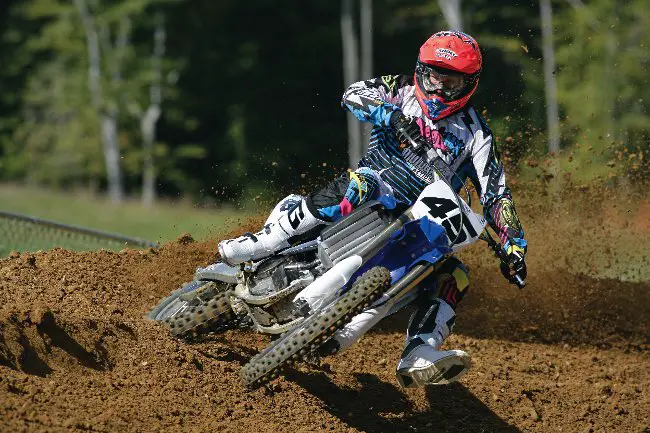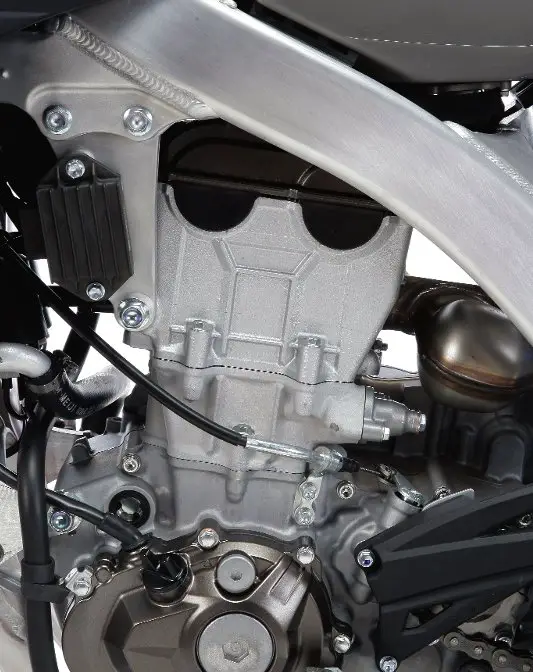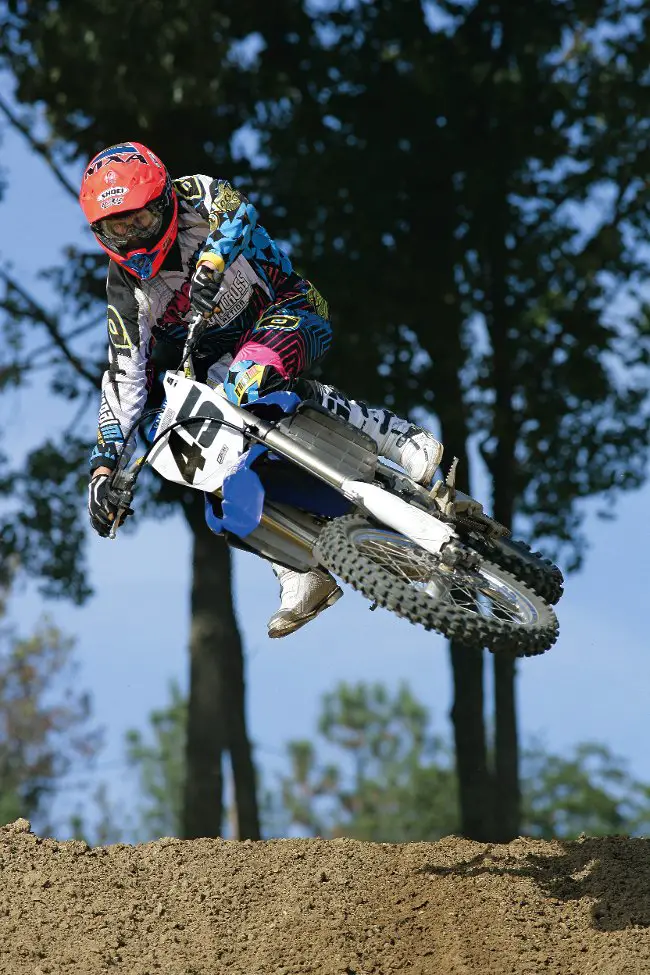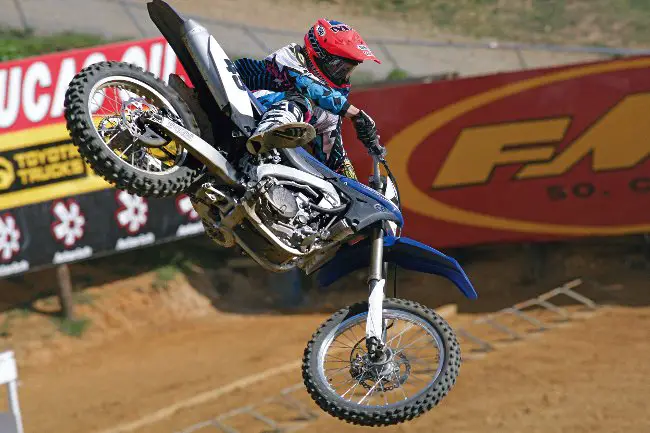REAL TESTS! 2010 MXA RACE TEST OF THE YAMAHA YZ450F:

Q: FIRST AND FOREMOST, IS THE 2010 YZ450F BETTER THAN THE 2009 YZ450F?
Q: WHAT ARE THE MAJOR CHANGES THAT YAMAHA MADE TO THE 2010 YZ450F?
A: Let’s not reiterate the complete list for the hundredth time. This is not a bike that has been released into a vacuum?there has been more pre-release publicity about the 2010 Yamaha YZ450F than any bike in the history of the sport. If you don’t know what Yamaha changed for 2010, then you aren’t getting very good Internet reception in your cave in Tora Bora. Here is the abbreviated edition:
(1) What didn’t they change? The wheels and brakes.
(2) What did they change? Everything else.
Q: IS THE 2010 YZ450F FASTER THAN THE 2009 YZ450F?
A: Yes, but don’t order a plaque for the wall. The 2009 Yamaha YZ450F was an easy target?muffled up with the atrocious ice cream cone muffler and blessed with mellow cams, the best accolade that the MXA wrecking crew could bestow on the 2009 YZ450F was that the power was “easy to use, but it is not a powerband worthy of a motorcycle sold as a race bike.” Hardly a rousing review.
Thus, the new fuel-injected, downdraft, four-valve 2010 YZ450F engine is night-and-day better than its older brother. In a head-to-head comparison, the 2009 has nothing on the 2010 YZ450F across the complete range of the powerband. Off the bottom, the 2010 engine is much stronger (almost guaranteed when you fuel inject a 450cc engine). Additionally, the new engine pulls harder through the middle and produces considerably more horsepower than its predecessor (approximately three more horses at peak).
Q: HOW WOULD WE DESCRIBE THE 2010 YZ450F’S POWERBAND?
A: Does the word “typical” seem too pedestrian? This is a cut-from-the-same-cloth fuel-injected motocross powerband. It shares most of its powerband traits with the RM-Z450, CRF450 and KX450F. It’s snappy, quick and responsive off the bottom. It doesn’t hesitate once the throttle is moved, and it makes the word “burble” as archaic as using “dames” to refer to women.

Four valve: One valve and one carburetor are missing.
Fuel-injected bikes don’t have personalities. They are automatons. Their personalities, if you can assign such human characteristics to machinery, are controlled by the electronic nebula of the ubiquitous black box. There is no variation allowed in a fuel injector’s electric master control. Open-loop, seven-sensor, 12-port, Keihin throttle bodies have one thing in common?and that is that they have everything in common.
So, we would describe the powerband of the 2010 YZ450F as “typical” of all the fuel-injected motocross bikes of the 21st century. It is strong and barky down low (perhaps too barky for some tastes) and pulls aggressively through the low-to-mid transition and peaks at 9200 rpm. It hangs after 9200. It’s got good power, but pales in comparison to the KTM 450SXF and Kawasaki KX450F.
Q: HOW DOES THE 2010 YZ450F RUN ON THE DYNO?
A: Maximum horsepower on our 2010 YZ450F was 52.63 ponies. Maximum torque was 33.02 foot-pounds. For comparison purposes, our 2009 YZ450F reached 49.54 horsepower and produced 32.62 foot-pounds of torque.
Compared to the 2010 Kawasaki KX450F and KTM 450SXF, the YZ450F gives up 1.1 and 1.3 horsepower respectively.
Q: HOW QUIET IS THE NEW MUFFLER?

Flight school: Although the 2010 YZ450F weighs five pounds more than the 2009 model, you can’t tell that it’s heavier when it is in the air.
Q: IS THE 2010 YAMAHA LIGHTER THAN THE 2009 YZ450F?
A: Heavens to Murgatroyd! No. With the exception of the fuel-injected Honda CRF450 (at 226 pounds), every other fuel-injected bike is a porker. The Yamaha gained 5.2 pounds. It took Yamaha five years to trim five pounds off the original YZ450F, and just like with any yo-yo diet?it’s back!
Q: HOW DOES YAMAHA’S FUEL INJECTION DIFFER FROM THE CRF450’s, KX450F’s AND RM-Z450’s EFI?
A: Let us count the ways:
(1) The Yamaha cylinder head was expressly designed for fuel injection (whereas Honda, Kawasaki and Suzuki just bolted the EFI throttle body on in place of the carburetor).
(2) Yamaha’s downdraft design is as close as any motocross bike has come to the ideal of direct injection (although only a mechanical moron could confuse the simplistic design of motorcycle fuel-injection with the intricacies of actual direct-injection). In short, the YZ450F intake tract doesn’t make any convoluted moves to get to the combustion chamber.
(3) Yamaha uses a 44mm Keihin EFI. Honda has a 50mm throttle body, while Suzuki, Husaberg and Kawasaki use 43mm orifices.
Q: WHAT IS UNIQUE ABOUT THE 2010 YAMAHA YZ450F ENGINE?
A: Answering this question is like shooting fish in a barrel.
Tilted cylinder: The YZ450F cylinder is tilted rearward by 8.2 degrees. (Given that the 2009 engine was tilted forward 4.5 degrees, that is a 12.7-degree shift).
Offset crank: It should be noted that Yamaha is not the first manufacturer to offset the centerline of the cylinder over the crankshaft, but by moving it 12mm, they take the cake for the most offset of all-time.
Bore and stroke: The 2009 Yamaha YZ450F had a 95mm bore by 63.4mm stroke. The 2010 YZ450F is decidedly more over-square, with a 2mm larger bore (97mm) and 2.6mm shorter stroke (60.8mm).
Four-valve head: The 2009 YZ450F had a five-valve Genesis head, which Yamaha adopted on their street bikes back in 1984. The switch to four valves started with the 2007 YZF-R1 street bike. The reason? With the five-valve design, the designers are restricted with respect to how much they can shape the combustion chambers. Switching to a four-valve design means the engineers have more area to reshape the combustion chamber. This is most evident in the higher compression ratio for 2010 (12.5:1 instead of the old 12.3:1).
Q: HOW DOES THE 2010 YAMAHA YZ450F HANDLE?
The first words out of every MXA test rider’s mouth was, “This thing is light!” And that statement is made all the more significant by the fact that the 2010 YZ450F isn’t light (it’s five pounds heavier than last year).
Yamaha’s slavish devotion to the concept of moving every major part of the engine towards the center of gravity has paid tremendous dividends in the “feel” department. This bike feels like a feather (as long as the wheels are off the ground).

Science guy: Handling is divided into pitch, roll and yaw. This is a good example of all three.
Q: WHAT ABOUT THE PUSH IN THE FRONT END?
A: After years of trying Band-Aid fixes on the earlier generations of YZ450F frames, Yamaha finally went all out with the new chassis they have needed for half a decade. With the new fork offset (reduced 3mm), head angle (steepened 0.1 degrees) and weight bias (2 percent farther rearward), the new frame rolls into corners with ease. The top-heavy feel of the old YZ450F is gone, replaced with a super-agile ability to transfer from one roll angle to the next. Thanks to the wonders of gravity, rotational moments of inertia and mass centralization, the 2010 YZ450F is better in pitch control than any other bike over a jump, it can easily be returned to normal with a flick of the throttle.
We can’t honestly say that it feels like a 250 four-stroke in motion, but it has managed to bridge the gap between a 250cc fighter jet and 450cc long-range bomber.
The old push in the center of the corner is gone, but it is replaced by a loose, castering feel on the entrance of turns. It’s better, but it is far from perfect.
Q: WHAT WERE OUR BEST FORK SETTINGS?
A: Yamaha may have built a totally new engine, fuel management system, exhaust pipe and ergonomic layout, but they didn’t need to reinvent the wheel when it came to the Kayaba SSS suspension.
No complaints, because the previous suspension was too good to mess with (except for spring and damping changes related to the new weight bias and head angle).
Spring rate: 0.47 kg/mm
Oil quantity: 355cc
Compression: 10 clicks out (13 clicks out)
Rebound: 9 clicks out (10 clicks out)
Fork leg height: 0mm up
Notes: The 2010 Kayaba SSS forks have 10mm more stroke (from 300mm to 310mm), are 7mm longer and have ten percent more low-speed compression damping (because there is more preload on the pressure spring). Additionally, the fork tubes have a 2mm smaller diameter where they pass through the top triple clamps. We have been testing shock linkages for the 2010 YZ450F and have had some success (but have yet to finalize the best all-around length).
Q: WHAT WAS OUR BEST SHOCK SETTING?
A: For hardcore racing, these are MXA‘s recommended 2010 YZ450F shock settings (stock settings are in parentheses).
Spring rate: 5.7 kg/mm
Race sag: 100mm
Hi-compression: 1-1/2 turns out (1-1/4 stock)
Lo-compression: 7 clicks out (8 clicks out)
Rebound: 11 clicks out (14 clicks out)
Notes: Most MXA test riders preferred less high-speed compression and more rebound
Q: WHAT DID WE HATE?
A: The hate list:
(1) Airbox 1. Let’s get this straight, Yamaha’s engineers built the most creative motocross bike of the last decade, but they couldn’t figure out how to get to the air filter. Maybe it’s just us, but removing six bolts and having to flip the gas tank vertically every time you want to put in a clean filter is just plain wrong.
(2) Airbox 2. Yes, we know that we just whined about the airbox in the paragraph above, but we aren’t done. Obviously Yamaha’s engineers aren’t disciples of pioneering physicist Daniel Bernoulli (1700?1782). Bernoulli’s Principle states that when air moves through a constriction, it increases in velocity (and, conversely, when it moves from a small opening into a larger opening, it decreases in speed). The 2010 Yamaha YZ450F’s unique radiator wing airbox is designed 180-degrees opposite of how it would be if Yamaha wanted increased air velocity going into the engine. The YZ450F’s small inlets dump into an expanded interior space, and the result is that the airflow is greatly reduced.
(3) Front tire. Yikes! Putting a Dunlop D742FA on the front of your new bike is like voluntarily giving up ten points on the handling scale. Lose this front tire fast.
(4) Textured plastic. Yamaha’s designers put a textured pattern on the large slabs of black radiator shroud plastic. When the bike is brand-new, the checkered plastic looks good, but after a few rides it looks frayed.
(5) Sound. Although Yamaha increased the size of the muffler on the YZ450F, at 96.4 dB it is not AMA legal. But, it is airbox sound that is most annoying to the rider.
Q: WHAT DID WE LIKE?
A: The like list:
(1) Oil sight glass. Although Yamaha has a terrible reputation for putting their sight glasses in the wrong place (last year’s YZ250F sight glass was 200cc too low), every MXA test rider vastly prefers a sight glass over a dipstick?especially one in the correct spot.
(2) Spring preload. Thanks to the backwards engine design, there is abundant access to the rear shock. Adjusting the preload, which can be extremely difficult to do on other brands, is a snap on the 2010 YZ450F.
(3) EFI Power Tuner. Unlike Kawasaki’s and Honda’s reprogramming devices, Yamaha’s Playstation-style GYTR Power Tuner does not require a laptop computer or 12-volt battery. It is a self-contained device that allows the fuel map and ignition timing to be changed at nine different rpm/throttle positions. Most MXA test riders chose the “less Hit” curve (which you can find in the February of MXA). The retail price is $279.95.
(4) Clutch cover. On the 2010 YZ450F, Yamaha built ridges onto the surface of the clutch cover to keep the rider’s boot from scratching the paint off the cover. Obviously, the YZ450F designers didn’t share this idea with the YZ250F designers. We’d like large ridges.
Q: WHAT DO WE REALLY THINK?
A: All that gee-whiz, Gyro Gearloose, slide-rule machinating on the design of the 2010 YZ3450F resulted in a bike that the typical home-schooled slacker wannabe can learn something from. This is a creative bike with educational value, but no matter how thin you slice it, the 2010 YZ450F boils down to two wheels and an engine. It may be one giant leap forward for techno-geeks, but it is, however, not a very big leap forward in performance.






Comments are closed.